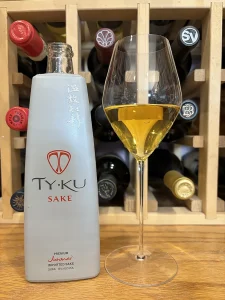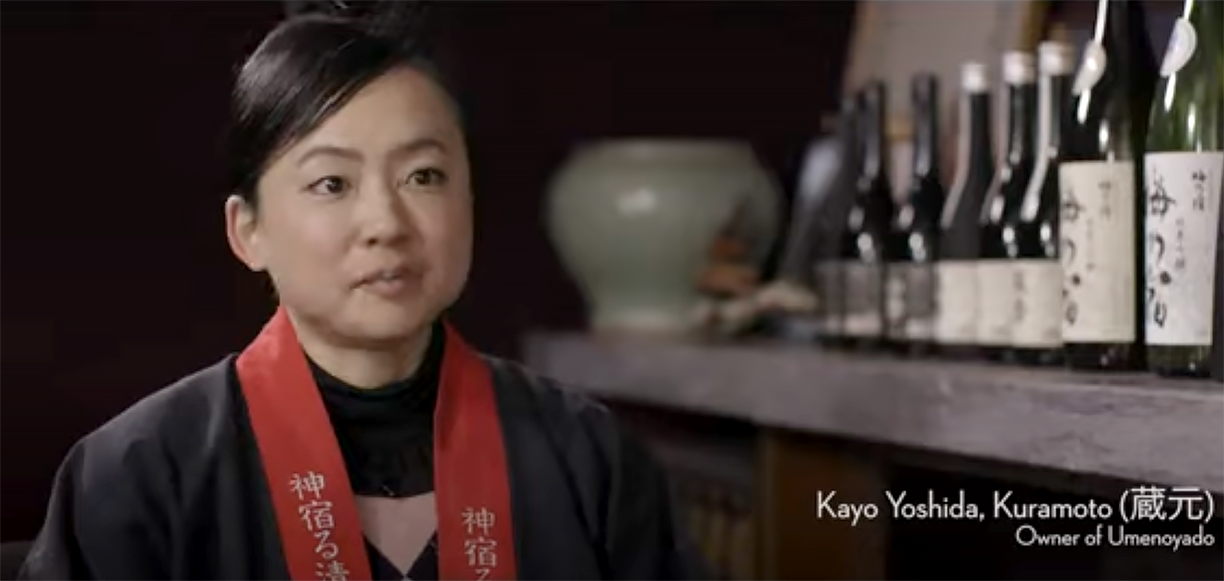Very pale amber color (this has been properly stored for five years, it likely was lighter color when younger); subtle pear notes on the nose and palate.

Very slightly sweet—SMV +1.9 (Sake Meter Value—SMV—indicates sweetness; positive number indicates drier, negative number sweetness). First level of premium saké with 30%+ polish (amount of outer layer of rice grain removed, the higher the polish percentage, the more refined is the taste).
Soft, silky, round in the mouth. Excellent acidity—1.7, which is high end for saké (typical range is 0.8 to 1.7). Amino acid 1.1, giving this medium richness and balanced flavor. The acidity levels give this a more robust and full-bodied profile. Lactic and succinic are the main acids in saké. They contribute to flavor profile and balance through the interaction with SMV and amino acid content. Chilled saké—recommended for this and other premium sakés—tones down the perception of acidity and alcohol, giving this a crisper, sharper taste. 15% ABV

Ty Ku (or TYKU) is a leader in premium saké. Made using only the four natural ingredients of premium saké—non-GMO rice, pure soft water, yeast, and hand-applied koji (special molds that break down starches into fermentable sugars, a fundamental element in saké production). The website notes its product is “The clean alternative to wine with 12-15% alcohol by volume, but Gluten-free, Sulfite-free, Tannin-free, and five times less acidity than wine. Crafted and imported from the famed Umenoyado Brewery right in the heart of Nara, Japan.”

The brewery has been overseen by the Yoshida Family for more than 124 years, spanning five generations. Kayo Yoshida currently runs the brewery. She is the first female brewery owner in Nara, Japan. Nara is considered the “birthplace of saké.”
Saké often is consumed young, but it can age, particularly higher quality saké, which this is. I have a particular shelf in my wine cellar where I am aging some select bottles to judge the effect. Definition: large wine refrigerators, usually six-feet tall and holding 150 bottles or more, are called wine cellars to separate them from much smaller wine refrigerators; I do not have a dedicated, refrigerated room to store and age my wine. This bottle of Ty Ku Saké Silver Premium Junmai was opened as part of extended project to explain saké and post reviews on my various Gus Clemens on Wine websites and newsletter.
Ty Ku Saké Silver Premium Junmai is smooth, subtle. Excellent balance of acidity and sweetness. With a SMV of +1.9, this is lightly dry saké, but all premium saké delivers richness and deliciousness. This certainly does. While saké often is sipped by itself or used in cocktails, this also is a versatile food beverage. Pair with pasta and other light Western cuisine; seafood, both fresh (sushi) and grilled; grilled and barbecued meats; roasted chicken; spicy Asian dishes; traditional Asian food. Cheese—look for mild to moderate flavors; mozzarella, ricotta, fresh goat cheese; gouda, comté; brie, camembert. In all choices, this is best served chilled. $10-11 (330 ml bottle—1/3 of a liter, 11 fluid ounces—equivalent price for a 750 ml wine bottle, around $25). Completely appropriate to serve in a white wine glass.
